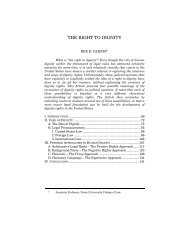A Right to Media? Lorie M. Graham - Columbia Law School
A Right to Media? Lorie M. Graham - Columbia Law School
A Right to Media? Lorie M. Graham - Columbia Law School
Create successful ePaper yourself
Turn your PDF publications into a flip-book with our unique Google optimized e-Paper software.
2010] A RIGHT TO MEDIA? 451<br />
B. <strong>Media</strong> and Indigenous Peoples’ <strong>Right</strong>s<br />
Beginning with the 1948 Universal Declaration of Human<br />
<strong>Right</strong>s, the international community has regarded freedom of<br />
expression and the right <strong>to</strong> information as inherent components of<br />
mankind’s fundamental human rights. The importance of free<br />
expression and the ability <strong>to</strong> access information and ideas through<br />
media has had a similarly long his<strong>to</strong>ry. This section demonstrates<br />
how, under the rubric of a right <strong>to</strong> media, these norms are linked <strong>to</strong><br />
the actualization of other fundamental human rights of particular<br />
relevance <strong>to</strong> indigenous peoples, including the right <strong>to</strong> nondiscrimination,<br />
the right <strong>to</strong> cultural and linguistic integrity, and the<br />
right <strong>to</strong> self-determination.<br />
1. Role of <strong>Media</strong> in Combating Discrimination<br />
Similar <strong>to</strong> other human rights, the media rights of expression<br />
and information are essential components of the effective promotion<br />
and protection of other important human rights. 83 The documents<br />
discussed in this section are intended <strong>to</strong> illustrate the linkages in<br />
international law between the principles of non-discrimination and<br />
the rights of expression and information through media. These<br />
linkages are particularly important within the context of Article 16 of<br />
UNDRIP for two reasons. First, the media often plays a dangerous<br />
role in perpetuating discrimination. Second, the media also occupies<br />
a unique position that enables it <strong>to</strong> combat discrimination against<br />
indigenous peoples.<br />
The International Convention on the Elimination of all<br />
Forms of Race Discrimination (the “Race Convention”) speaks<br />
directly <strong>to</strong> the issue of non-discrimination and the right <strong>to</strong> freedom of<br />
opinion and expression, connecting the advancement of these rights<br />
<strong>to</strong> the prohibition and elimination of racial discrimination. Article 7<br />
of the Race Convention goes one step further and imposes a duty on<br />
States <strong>to</strong> “undertake <strong>to</strong> adopt immediate and effective measures,<br />
particularly in the [area] of . . . information, with a view <strong>to</strong> combating<br />
prejudices which lead <strong>to</strong> racial discrimination and <strong>to</strong> promoting<br />
understanding, <strong>to</strong>lerance and friendship among nations and racial or<br />
83. See Toby Mendel, Freedom of Information 1 (2d ed. 2008), available at<br />
http://portal.unesco.org/ci/en/files/26159/12054862803freedom_information_en.pd<br />
f/freedom_information_en.pdf.















